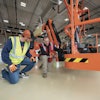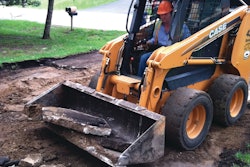
What do you do when your market dries up?
That was the question faced by Valley Blacktopping, an Eagan, Minn., paving contractor that for years had generated the bulk of its sales from the new construction boom in and around the Twin Cities.
But when the economy hit the skids, new construction came to a screeching halt. Valley Blacktopping was hit hard, like so many other contractors.
A family-owned and operated business started by Russ Johnson in 1976, Valley Blacktopping worked for 20 years to become the go-to paving contractor for new construction, particularly new construction of houses. Ryan Johnson -- grandson of Russ, son of co-owner Ritchy, and nephew of co-owner Scott -- says Valley Blacktopping had an efficient, high-volume system for installing new driveways. The contractor ran one base construction crew and one paving crew and would typically construct between 40 and 50 townhouse driveways (16 ft. x 26 ft.) every day.
“We could do one driveway in 15 minutes, and there were days when if we didn’t do 50 driveways we were falling behind,” Johnson says, adding that the company’s record for driveways was 76 in one day.
But that was during the boom, when their relationships with builders made Valley Blacktopping first in line for contracts and when there was so much construction going on that there was always another driveway to build in the next development.
“Throughout the 1990’s big boom in homebuilding they couldn’t throw houses up fast enough and we saw it and we knew that would be a way to grow our business,” Johnson says. “So we pursued it and for about 18 years we were the only paving contactor one of the homebuilders used.”
He says that throughout that time 75 percent Valley Blacktopping’s work was new construction, 25 percent residential tear-out and replace “and maybe we’d do a parking lot here and there.”
“We had no time to do anything else,” Johnson says. “We’d literally throw away stacks of requests for proposals every couple of months just because we couldn’t get to them.”
Recession = reexamination
But as the recession hit they realized they were going to have to make a drastic change if Valley Blacktopping was going to continue its steady growth. How did they know? They got the hint from their home builder customer.
“The primary home builder we worked with underwent some changes and they changed the way they hired their contractors,” Ryan says. “They brought in one of our competitors and when we realized that and recognized that housing construction had slowed we decided we had to look at what we were going to do.”
To begin with the company took new work -- any work -- as it came up, including excavation, installing drain tiles, constructing concrete sidewalks and snowplowing. “We are a blacktop company, that’s our bread and butter. It’s what we do and we do it well,” Johnson says. “But we’re pretty flexible and adaptable, too, and sometimes you have to just find something to do if you can’t pave.”
Then they examined the recession market, decided residential work was their specialty, and made a concerted effort to become the Twin Cities’ driveway reconstruction specialist. Over the last couple of years, as their residential reconstruction work has solidified, Valley Blacktopping has become more involved in removal and reconstruction of residential and commercial parking lots as well.
Today Valley Blacktopping employs 15 people including Russ, Ritchy, Scott, Ryan and Russ’s wife, Marcia, who handles the accounting and is secretary/treasurer. The contractor generates 50 percent of sales from driveway overlays and remove-and-replace paving jobs, 45 percent from parking lot work, and 5 percent from new construction paving (including one or two new driveways every few weeks) and snow removal.
Driveway Contractor's Tips for How to Work with Homeowners
But how did Valley Blacktopping shift from 50 percent new construction to 95 percent repair? Johnson says that where 2008 and 2009 were slower years, “by 2010 the phones were ringing off the hook compared to 2009.”
How did that happen? The company realized it needed to do some marketing to improve sales. “We never spent much money on advertising before and we were always busy enough so we didn’t need to,” he says. “But with a slower economy we needed to do something to generate more sales.”
Anatomy of the website
So they put up a website (www.valleyblacktopping.com). Actually, Ryan Johnson put up the website on his own in 2009. “We needed to have an online presence because that’s where people are going,” he says. “And because the company was shifting its focus to the residential replacement market we needed to find a way for those people to find us.”
Johnson, who describes himself as “self-taught but tech savvy,” used a free website template to create a generic website that did little more than enable people to contact the company. But it did give Valley Blacktopping an online presence and he showed it to the family after it was all up and running.
At first the rest of the family didn’t want a website, the general feeling being “We’ve got ads in the phone book and that’s all we need,” Johnson says. “When they started seeing I was getting emails asking for estimates they started to see its value.”
But old habits die hard. Johnson says the company still ran ads in the phone book though hardly anyone found the company that way. “We had very, very limited advertising prior to putting up the website; just ads in two phone books, that’s all,” he says. “Two years ago we stopped paying for those ads and now all our commercial vehicles have the website on them.”
Working the website
In 2010 Valley Blacktopping upgraded its website and spent some marketing dollars on web-based advertising. Johnson says that since then the impact of the website has intensified.
Where the site initially provided only an opportunity for people to contact the contractor, the redesigned site features a dozen pages visitors can click on including an About Us page and separate pages for residential work, commercial work, driveway care and a photo gallery where pictures of completed jobs scroll slowly by. Every page also includes a link to contact the company directly for either an e-mail reply or a phone number.
Once the site was upgraded the next step was to improve its ranking on search engines such as Google so that when people were looking for a contractor like Valley Blacktopping, Valley Blacktopping came up near the top of the list on the first search page.
Johnson investigated and started to use Google Adwords, which is Google’s primary revenue source. Websites such as Valley Blacktopping “buy” specific words and when a visitor uses those words in a search and is directed to Valley Blacktopping’s site, the site is charged a small fee. Johnson says the investment in Google Adwords paid off as Valley Blacktopping climbed high on Google. Then he began paying close attention to Google Analytics, a Google service that tracks for website owners what exactly is happening with their website.
“Google Analytics lets me know what search engines people are using, how many people keyed in our web address and how many keyed in our company name only. It tells me the click-through rate, how long visitors stay on the website, what pages are visited, how many unique visitors we get a month, where they are searching from – it’s a lot of good information,” he says.
He says Google Analytics showed him that the site’s Home Page is the page most visited, followed by About Us. “Next is Residential Services and people must go there to see if we offer what they want done,” Johnson says.
He says the site averages 200 visitors each month during the summer and between 30 and 40 percent of those visits result in a request for an estimate. “I think that’s pretty good,” he says.
He says once people visit the site and decide to contact the company they do it almost equally via e-mail and phone. “A lot of times people have questions they want answered right away so they call instead of email,” he says.
Ryan says that during peak season the website generates five to 10 requests for estimates each week via e-mail and another six or so phone calls from people who say they’ve seen the website and want an estimate. “The majority of calls that come in have already gone to the website before they call us,” he says. “We did a survey and with a 30 percent return rate found that 90 percent of the people said they found us on the Internet.”
Johnson says the website is due for an upgrade again soon, but until then he adds photos at least once a year.
“The website truthfully is invaluable,” he says. “It’s been a huge factor in our successful shift into the residential replacement and repair market.”



















